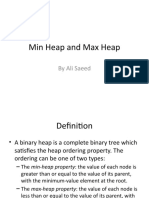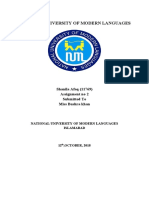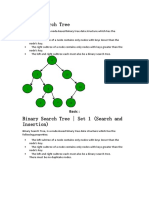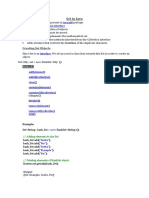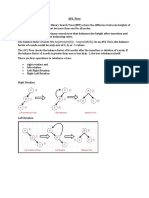0% found this document useful (0 votes)
271 views7 pagesBinary Search Tree - Notes
A binary search tree is a binary tree where all nodes to the left of a parent node are less than the parent and all nodes to the right are greater. Nodes are inserted by comparing the new node value to the root and traversing left or right. Nodes are deleted by checking if the node has 0, 1, or 2 children and handling each case differently such as replacing with the minimum node from the right subtree. Searching works by comparing the search value to each node and traversing left or right until found or reaching a leaf.
Uploaded by
sathwik vaguCopyright
© © All Rights Reserved
We take content rights seriously. If you suspect this is your content, claim it here.
Available Formats
Download as DOCX, PDF, TXT or read online on Scribd
0% found this document useful (0 votes)
271 views7 pagesBinary Search Tree - Notes
A binary search tree is a binary tree where all nodes to the left of a parent node are less than the parent and all nodes to the right are greater. Nodes are inserted by comparing the new node value to the root and traversing left or right. Nodes are deleted by checking if the node has 0, 1, or 2 children and handling each case differently such as replacing with the minimum node from the right subtree. Searching works by comparing the search value to each node and traversing left or right until found or reaching a leaf.
Uploaded by
sathwik vaguCopyright
© © All Rights Reserved
We take content rights seriously. If you suspect this is your content, claim it here.
Available Formats
Download as DOCX, PDF, TXT or read online on Scribd
/ 7














